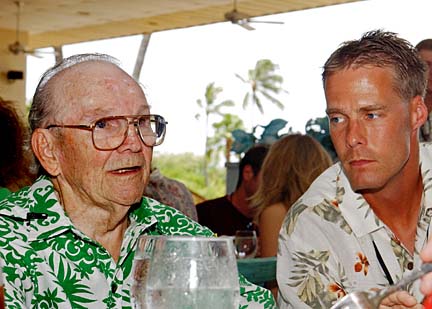

|
Straight to the source
Teachers bypass the textbooks to hear
Pearl Harbor vets tell it like it was
History teachers from the mainland are on Oahu this week to see the Japanese attack on Pearl Harbor through the eyes of its survivors.
The 100 teachers are looking for firsthand experiences that can't be found in any textbooks, movie or documentary, so they can make history come alive for their students, said Josephine Manfre of Neptune High School in Neptune, N.J.
The East-West Center's AsiaPacificEd Program for schools is co-sponsoring the Sunday-through-Friday workshop, "Remembering Pearl Harbor: History, Memory and Memorial." It was made possible with a $155,000-plus grant from the National Endowment for the Humanities, with contributions from the Arizona Memorial Museum Association and the National Park Service.
Participants met with the news media yesterday at the Hickam Air Force Base Officers Club after two days of talks with 10 Pearl Harbor survivors.
Stephanie Robinson of Fultondale High School in Birmingham, Ala., said she likes to "have firsthand experiences, stories of real people" to make history "more real for my kids. It's not just dates and times, but emotions, what they were feeling."
Young people who watched the Sept. 11, 2001, attacks on TV can relate to some of the terror that the survivors must have felt, she said.
Robinson asked Everett Hyland, who loaded antiaircraft guns on the USS Pennsylvania and was awarded the Purple Heart, what it was like the morning of Dec. 7, 1941.
Hyland, now 81, said he had shrapnel wounds all over his body.
"Blood was coming out of my left leg. I poked my finger in the hole to stop the bleeding, like my old Boy Scout training said to do. My finger went in up to the second knuckle, and I figured I'd rather bleed."
He continued to load the guns for over an hour. As soon as his nine-month stay in the hospital was over, he went back to sea until the war ended.
Hyland said he met his wife, Miyoko, of Japan, at the 50th anniversary of the Pearl Harbor attack. They were attending a reunion in which survivors of the war from both sides came together for reconciliation.
Teachers Christopher Wyglendowski of Lebanon Township, N.J., and Avi Black from San Francisco said they were impressed hearing the native Hawaiian perspective given by Jon Osorio, director of Hawaiian studies at the University of Hawaii.
Black said he was struck by the fact that in 1941, Hawaii was not even a state, just a U.S. territory, yet isle residents were "able to summon up the support to join the cause and fight against the Japanese."
Wyglendowski said the "biggest thing I'll take back with me is the complexity of it all. There's not just one story. It's simplistic to say this is the American or Japanese or Hawaiian story. We got to hear a lot of stories" that showed them how "incomplete (history is) to just read textbooks and watch movies."
www.eastwestcenter.org/edu-st.asp